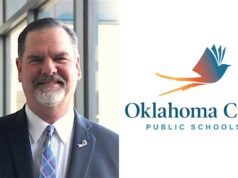This fall, 585 of Oklahoma City’s public school educators completed an anonymous survey created by the American Federation of Teachers. As The Oklahoman’s Tim Willert reported on Oct. 30:
About 80 percent of district teachers who responded to a union survey said they are responsible for administering the majority of student discipline. … About 65 percent of teachers surveyed said greater enforcement of traditional discipline methods for offensive behavior would have the greatest impact on making them more effective teachers.
In a Nov. 6 Tulsa World article, Tulsa Classroom Teachers Association President Patti Ferguson-Palmer is quoted as saying that Tulsa administrators and even teachers of the youngest students are “frozen into inaction for fear of losing their jobs.” Ferguson-Palmer has observed, “In some cases, teachers are afraid to have students use pencils and scissors in activities for fear that they will be used as weapons.”
More recently, as reported Monday by Brett Dickerson in the Oklahoma City Free Press, AFT-OK president Ed Allen presented these findings to the OKCPS board this week. Allen said that, “85 percent of teachers believe the district is in decline.” He also said the district does some great things, but it has serious, longstanding problems. Allen urged the system and the union membership to avoid an us-versus-them approach to the criticisms and warned that “forces on the outside” will make the overall system even more vulnerable if action isn’t taken.
The OKCPS estimates that there are 1,500 chronically disruptive students, but it lacks the capacity to address that issue. OKCPS teachers also complained about class size, a lack of planning time, and lesson plans as long as nine pages.
More survey results
The second-largest group of survey answers stressed the impossible demands on teachers’ time, especially due to curriculum and instruction programs. Only 14 percent of respondents agreed that, “Benchmarks provide useful data regarding my students’ progress toward mastering the standards.” Only 23 percent said that curriculum coordinators made a slight or significant impact. The majority of teachers either said that they were unsure whether instructional coaching is producing results or that it is not improving instruction.
Allen said that while the survey found a little less verbal defiance, 9 percent of respondents reported physical violence against them.
Although a completely scientific poll would have been too expensive, the AFT-OK president said during questioning at the board meeting that they had made an effort to create unbiased questions. Allen explicitly said that the results don’t mean that the teachers are always right and the administration is always wrong on these controversies, adding he has taken a political hit for his efforts to bridge differences.
Diving into the OKCPS survey’s comments
I studied 281 additional comments made by the teachers in the survey. Nearly 40 percent of them complained about the the district administration’s lack of disciplinary backing. Less than 2 percent of the commenters blamed their fellow teachers for the chronic disruption or said something positive about the central office. Some said that the PBIS classroom management system that the district provides would work in classes where there are only one or two disruptive students, but teachers are overwhelmed in classes with multiple chronically disruptive students. Others were dismissive of PBIS, with one referring to it as “a joke.”
One teacher complained about a student who wasn’t disciplined after he or she slugged the teacher three times. Another commenter protested that he or she had received a brain concussion because of a student-related altercation. A teacher complained about being kicked hard enough to leave scars, while another protested the lack of meaningful consequences for a student caught with a knife. One comment decried the lack of discipline for lewd behavior: “I would like to see a consequence for bad behavior of some kind such as when a male student pulled his penis out and showed it to another girl student.”
Many of the complaints are hard to tabulate because they described problems intertwined with large class sizes, a lack of resources and a reduction in teacher supports as new paperwork is imposed. I would say that the second-biggest set of complaints were bitter rejections of the administration’s curriculum and instruction initiatives. About a third of the comments are critical of the administration’s curriculum policies, its benchmark testing and/or the central office’s instruction coaches.
Benchmarks ‘a joke’, instructional coaching ‘a waste’, central office ‘a circus’
Even though the district no longer has to teach to the test, the periodic assessments known as benchmarks seem to anger today’s teachers as much as they upset me during the No Child Left Behind era. Benchmark testing takes up most of the instruction time devoted to testing. I believe that those assessments can be beneficial, but poorly done benchmarking can be the most destructive practice spawned by test-driven school reform.
Three commenters said that benchmark tests are “a joke,” four others said they are “a waste of time,” one said they are “totally irrelevant to what I’m teaching” and one said they are “unnecessary and create more things that are due.”
Similar sentiments were expressed about the instructional coaching system. It was derided as a “waste of time,” a “waste of money” and a way to make teachers “jump through an ordinate number of hoops.” Similarly, the teacher-evaluation system was said to be a way to push out veteran teachers, to micromanage and to turn teachers into “cookie cutter teachers” and “hoop jumpers.”
Teachers often expressed support for their principal but blamed central-office micromanaging. One commented, “I feel valued and supported by my school administrators. I do not feel supported or valued by district staff.” Others were more blunt about the central office. One called it a “circus.” Another said that disciplinary backing would be nice, but “I would settle for administrators who support and help teachers, not beat us down.”
One 28-year veteran wrote that the “… OKCPS, long recognized for their contempt for teachers, continues to double down on an erroneous template that drives good people out.”
I agree.
Reaching critical mass
When reading about Oklahoma teachers’ complaints over the lack of disciplinary backing, time wasted on instructional “silver bullets,” testing mandates, “gotcha” evaluations and central-office micromanaging, we must remember that the same problems have worsened across the nation — especially in urban districts.
Further, most of today’s complaints are the same as those we uttered – or held inside – during my career in the 1990s. There are, however, two differences:
- The OKCPS no longer needs to impose instructional mandates (which most teachers will always dismiss as educational malpractice anyway) to jack up test scores.
- The federal government no longer prohibits the district from shifting money from discredited, instructional micromanaging to the student supports that are doubly necessary in times like these.
At the same time, there is a new threat: The cumulative effects of years of demanding the impossible from teachers seem to be reaching a critical mass.






















